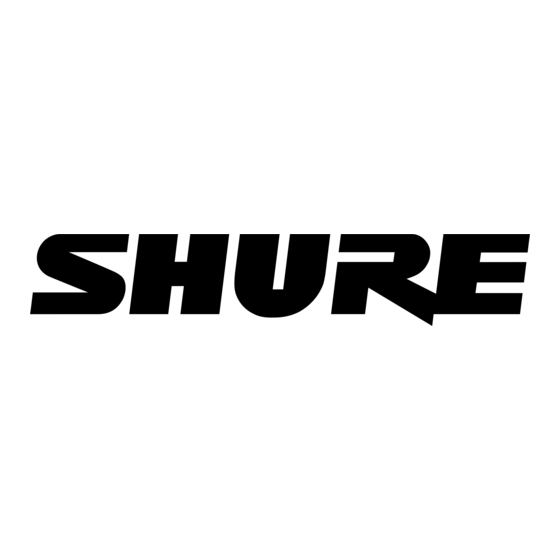Table of Contents

Summary of Contents for Shure KSM44A
- Page 1 User Guide Le Guide de l’Utilisateur Bedienungsanleitung Guía del Usuario Guida dell’Utente ユーザーガイド Руководство пользователя 取扱説明書 사용자 안내서 KSM44A 用户指南 www.shure.com N108 © 2010 Shure Incorporated Printed in U.S.A. 27A14307 (Rev. 2)
- Page 2 Over 85 years of audio experience has contributed to making this one of the finest microphones available. If you have any questions not answered in this guide, please contact Shure Applications Engineering at 847-600-8440, Monday through Friday, from 8:00 am to 4:30 pm, CST. In Europe, call 49-7131-72140.
-
Page 3: General Description
KSM44A features an externally biased, dual 1-inch diaphragms, extensive internal pop filtering and Prethos™ Advanced Preamplifier Technology for a ground-breaking threshold minimum of self-noise. The KSM44A is the premier choice for the highest level of professional studio and stage performance. -
Page 4: Performance Characteristics
Acoustic environments and microphone placements strongly affect the sound obtained from mik- ing a source, especially with a high-resolution microphone like the KSM44A. You may need to experiment with placement, room treatments and polar pattern to achieve the best overall sound for each application. -
Page 5: Operation
The three position switch on the front of the microphone sets the polar response pattern. This changes the microphone’s sensitivity to sounds coming from different angles. Cardioid. Picks up sounds directly in front of the microphone and is least sensitive to those in back. This is most commonly used in studio recording and live-sound applications. -
Page 6: Setting Attenuation
Load Impedance Maximum SPL capability, output clipping level, and dynamic range vary with the input load impedance of the preamplifier to which you connect the microphone. Shure recommends a minimum input load impedance of 1000 Ω. Most modern microphone preamplifiers meet this requirement. Higher impedance results in better performance for these specifications. -
Page 7: Specifications
1000 Ω load *THD of microphone preamplifier when applied input signal level is equivalent to cartridge output at specified SPL **S/N ratio is the difference between 94 dB SPL and equivalent SPL of self noise, A-weighted † 1 Pa=94 dB SPL... -
Page 8: Accessories And Parts
Meets Harmonized Standards EN55103-1:1996 and EN55103-2:1996, for residen- tial (E1) and light industrial (E2) environments. The Declaration of Conformity can be obtained from: Authorized European representative: Shure Europe GmbH Headquarters Europe, Middle East & Africa Department: EMEA Approval Wannenacker Str. 28... - Page 9 61 cm (2 ft.) Cardioid 61 cm (2 ft.) Bi-directional 61 cm (2 ft.) Omnidirectional TYPICAL FREQUENCY RESPONSE COURBE DE REPONSE TYPIQUE TYPISCHES FREQUENZVERHALTEN RESPUESTA DE FRECUENCIA TIPICA TIPICA RISPOSTA IN FREQUENZA 周波数特性 OVERALL DIMENSIONS – DIMENSIONS HORS TOUT GESAMTABMESSUNGEN – DIMENSIONES TOTALES – DIMENSIONI TOTALI – 寸法...
- Page 10 “ShureLock” are registered trademarks of Shure Incorporated in the United States. “Popper Stopper” is a trademark of Shure Incorporated in the United States. “Mylar” is a registered trademark of E.I. DuPont de Nemours and Company in the United States. These marks may be registered in other jurisdictions.









Need help?
Do you have a question about the KSM44A and is the answer not in the manual?
Questions and answers